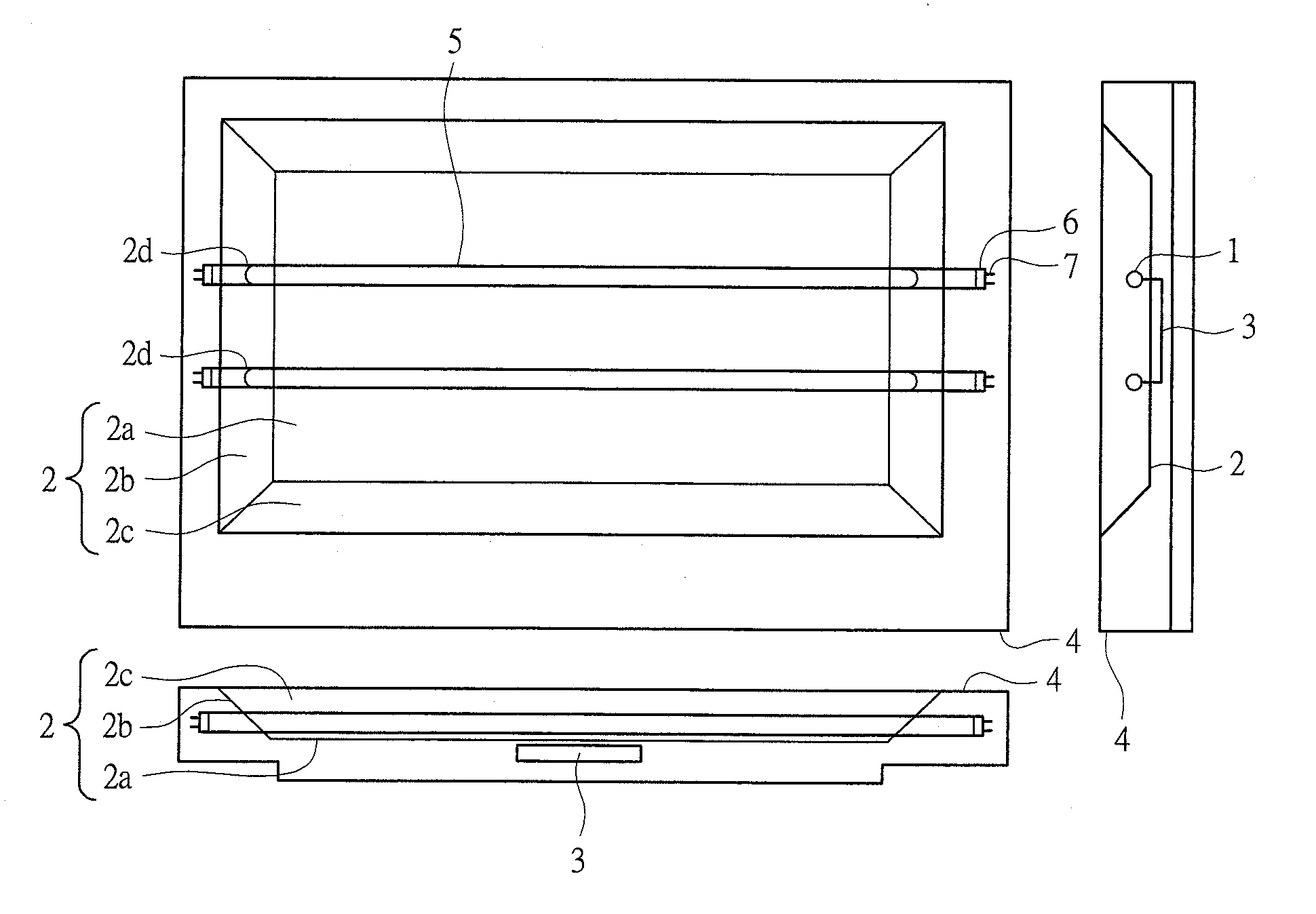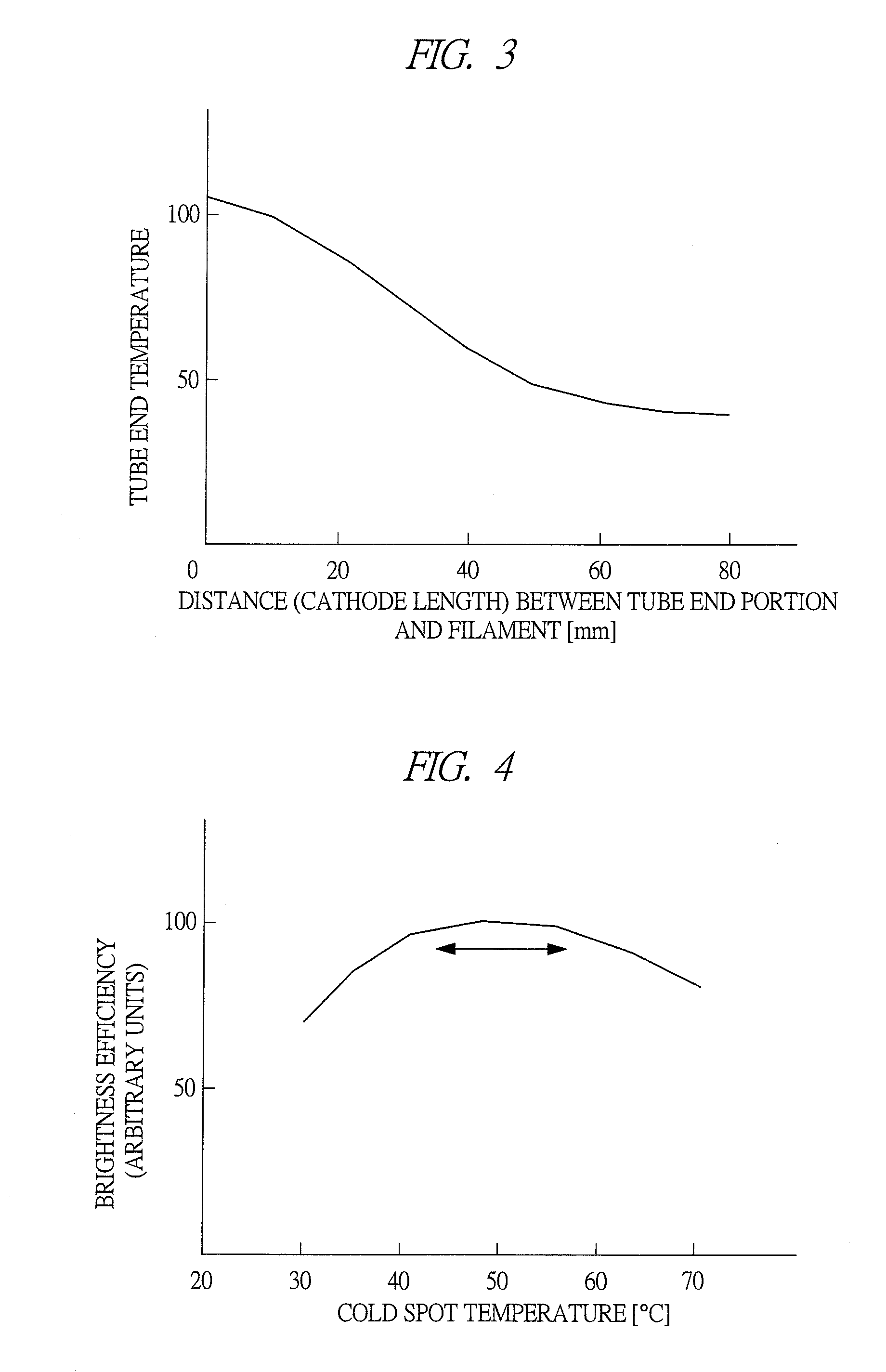Backlight and liquid crystal display device
- Summary
- Abstract
- Description
- Claims
- Application Information
AI Technical Summary
Benefits of technology
Problems solved by technology
Method used
Image
Examples
first embodiment
[0040]With reference to FIGS. 1 to 4, a first embodiment according to the present invention is described with using a backlight used for a 32-inch liquid crystal television (one type of a liquid crystal display device) as an example.
[0041]FIG. 1 is a view illustrating a schematic structure of the backlight used for the liquid crystal display device according to the first embodiment. FIG. 2 is a view illustrating a cross-sectional schematic structure of a hot cathode fluorescent tube 1 configuring the backlight according to the first embodiment. FIG. 3 is a graph illustrating a dependency of a tube end temperature of a tube end portion in the hot cathode fluorescent tube 1 with respect to a distance (cathode length) between the tube end portion of a bulb and a filament. FIG. 4 is a graph illustrating a dependency of brightness efficiency with respect to a cold spot temperature in a case that a longer cathode length of the hot cathode fluorescent tube 1 is 40 mm.
[0042]As illustrated i...
second embodiment
[0070]FIG. 5 is a view illustrating a schematic structure of a backlight used for a liquid crystal display device according to a second embodiment. Hereinafter, only different points from the first embodiment are described. Additional components to the schematic structure illustrated in FIG. 1 are: a vent (intake vent) 11a; a vent (exhaust vent) 11b; a partition plate 12; and a vent path 13. The vent (intake vent) 11a and the vent (exhaust vent) 11b are provided above and below the bottom cover 4, and the partition plate 12 is provided so as to fill a space between the bottom cover 4 and the reflective plate 2. The vent path 13 is a region surrounded by the bottom cover 4, the partition plate 12, the reflective-plate side surfaces 2b and 2c, vents 11a and 11b, and others. By providing the vent path 13, hot air caused by the heat radiated from the end portion of the hot cathode fluorescent tube 1 arranged from the reflective-plate side surface hole 2d toward the outside of the lamp h...
third embodiment
[0077]FIG. 8 is a view illustrating a schematic structure of a backlight used for a liquid crystal display device according to a third embodiment. In FIG. 8, a different point from the second embodiment is that a fan 16 is provided in a vicinity of the vent (exhaust vent) 11b. By the fan, the tube end portion 10 being the cold spot of the hot cathode fluorescent tube 1 can be further cooled. As a result, the cold spot temperature can be optimized, and therefore, the brightness efficiency of the hot cathode fluorescent lamp can be improved. Also, compared with the conventional technique, there is no cause of decreasing yield in the technique, and therefore, an effect of suppressing the decrease of the yield can be obtained. Note that, in FIG. 8, the fan 16 is provided in the vicinity of the vent (exhaust vent) 11b. However, a structure of the fan is not limited to this, and the fan 16 may be provided, for example, in a vicinity of the vent (intake vent) 11a, or in both of the vents 1...
PUM
 Login to View More
Login to View More Abstract
Description
Claims
Application Information
 Login to View More
Login to View More - R&D
- Intellectual Property
- Life Sciences
- Materials
- Tech Scout
- Unparalleled Data Quality
- Higher Quality Content
- 60% Fewer Hallucinations
Browse by: Latest US Patents, China's latest patents, Technical Efficacy Thesaurus, Application Domain, Technology Topic, Popular Technical Reports.
© 2025 PatSnap. All rights reserved.Legal|Privacy policy|Modern Slavery Act Transparency Statement|Sitemap|About US| Contact US: help@patsnap.com



